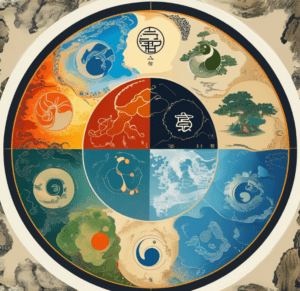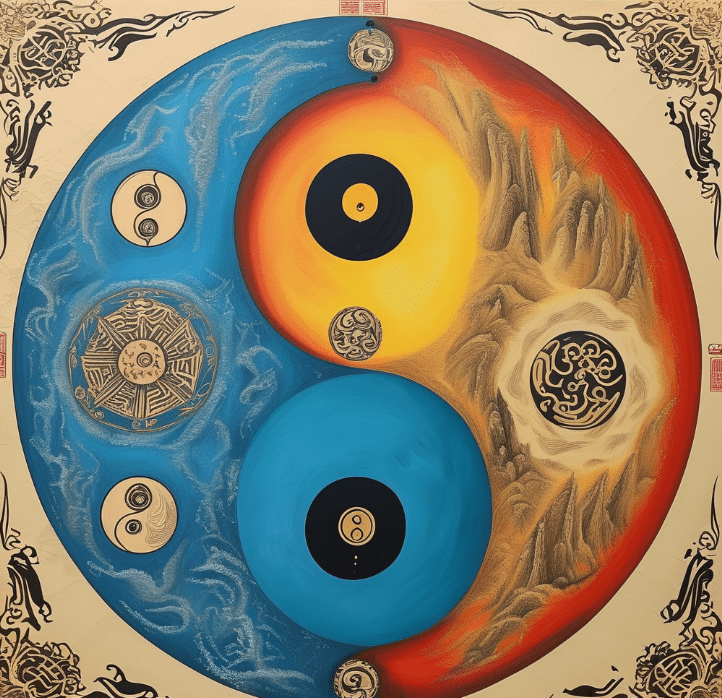In the study of feng shui, the Bagua (Eight Trigrams) and yin-yang are inextricably linked, together forming the core framework of feng shui theory. They guide people in arranging and adjusting their living and working environments to achieve an ideal state of harmony and balance.
The Connotations and Symbolism of the Bagua

The Bagua, an essential part of ancient Chinese philosophy, contains rich natural phenomena and cosmic laws. It consists of eight basic symbols: Qian (Heaven), Dui (Lake), Li (Fire), Zhen (Thunder), Xun (Wind), Kan (Water), Gen (Mountain), and Kun (Earth). Each symbol represents a specific natural element and symbolic meaning.
– Qian (Heaven) : Represents the sky and symbolizes creativity and power. In feng shui, the Qian position is often associated with career, authority, and other positive, uplifting matters, making it one of the most yang-filled directions.
– Dui (Lake) : Represents oceans, rivers, and marshes. The Dui position in feng shui is linked to wealth and communication. The flow of water symbolizes the circulation of wealth and interpersonal interactions, also reminding people to pay attention to the layout of water to avoid adverse factors such as floods.
– Li (Fire) : Represents fire and the sun, symbolizing brightness and passion. The Li position is closely connected to light, vitality, and interpersonal relationships. The warmth and brightness of fire can dispel gloom and bring positive energy, but it is also important to control fire to prevent it from becoming too strong and causing disasters.
– Zhen (Thunder) : Represents thunder and lightning, symbolizing vibration and stimulation. The Zhen position in feng shui is associated with action and decisiveness. The vibration of thunder and lightning can stimulate people’s potential and drive, promoting the development and change of things, but it is also necessary to be aware of the destructiveness of thunder and lightning to avoid being too impulsive.
– Xun (Wind) : Represents wind, symbolizing gentleness and transmission. The Xun position is related to communication, dissemination, and flexibility. The softness of the wind can transmit information and energy, making things more agile and harmonious, but too strong winds can bring instability and turmoil.
– Kan (Water) : Represents the moon, symbolizing yin and change. The Kan position is closely linked to wisdom, intuition, and emotions. The waxing and waning of the moon symbolizes the ups and downs and uncertainties of things, reminding people to adapt to changes and respond flexibly, while also paying attention to the regulation and balance of emotions.
– Gen (Mountain) : Represents mountains and land, symbolizing stability and solidity. The Gen position is associated with stability, safety, and foundation. The majesty of mountains and the vastness of land provide a solid foundation for all things, but in feng shui, it is also important to avoid being too rigid and stubborn, maintaining a certain degree of flexibility and adaptability.
– Kun (Earth) : Represents the earth, symbolizing inclusiveness and nurturing. The Kun position is one of the most yin-filled directions, associated with maternal love, inclusiveness, and the accumulation of wealth. The vastness and fertility of the earth nurture all things, also reminding people to cherish resources and focus on accumulation and sedimentation.
The Mutual Influence of the Bagua and Feng Shui

In the practice of feng shui, the directions and symbolic meanings of the Bagua have important guiding roles in environmental layout. For example, in home feng shui, the Qian position is usually located in the northwest direction, suitable for setting up a study or office to facilitate career development and improvement; while the Kun position is located in the southwest direction, suitable for placing storage cabinets or decorative items to promote the accumulation of wealth and family harmony.
The Five Elements theory in feng shui is also closely linked to the Bagua. The Five Elements include metal, wood, water, fire, and earth, which interact through generation and overcoming cycles, corresponding to the symbolic elements of the Bagua. For example, Qian and Dui belong to metal, Zhen and Xun belong to wood, Kan belongs to water, Li belongs to fire, and Gen and Kun belong to earth. In feng shui layout, it is necessary to reasonably match the elements of the Bagua directions according to the principles of the Five Elements’ generation and overcoming to achieve a balanced and harmonious effect. For instance, if the wood element is too strong in a certain space, appropriate metal elements can be added in the corresponding Zhen and Xun directions to overcome the wood and achieve balance.
The Application of the Bagua in Feng Shui

The application of the Bagua in feng shui is extensive and profound, not limited to home feng shui, but also involving commercial, architectural, and garden fields. In commercial feng shui, the fire element of the Li position is closely related to the prosperity and vitality of business. Merchants will attract customers and enhance the business atmosphere by setting up bright lighting and warm colors in the Li position; while in architectural feng shui, the stability and solidity of the Gen position are applied to the foundation and structural design of buildings, ensuring the safety and stability of the buildings.




